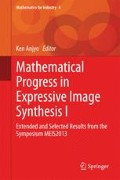Abstract
The spherical harmonics are the angular portion of the solution to the Laplace equation in spherical coordinates and provide a frequency-basis for representing functions on the sphere. The spherical harmonic lighting, as defined by Robin Green at Sony Computer Entertainment in 2003, is a family of real-time rendering techniques that may produce certain realistic shading and shadowing with relatively small overhead lighting. All such spherical harmonic lighting techniques involve replacing parts of standard lighting equations with spherical functions that have been projected into a frequency space using the spherical harmonics as a basis (or a weight space of irreducible finite dimensional representation of the rotation group). In this chapter, using a group theoretical background of spherical harmonics and rather simple realization of the space of functions on the two dimensional sphere in the frame work of representation theory, we propose a possible geometry preserving algebraic/efficient computing, which might accelerate the (numerical and exact) computations slightly for spherical harmonic lighting.
Access this chapter
Tax calculation will be finalised at checkout
Purchases are for personal use only
References
Basri R, Jacobs DW (2003) Lambertian reflectance and linear subspaces. IEEE Trans Pattern Anal Mach Intell 25:218–233
Dobashi Y, Kaneda K, Nakashima E, Yamashita H, Nishita T (1995–1999) A quick rendering method using basis functions for interactive lighting design. Comput Graph Forum (Proc EUROGRAPHICS’95) 14(3):229–240
Faraut J (2008) Cambridge Studies in Advanced Mathematics. In: Analysis on lie groups, vol 110. Cambridge University Press, Cambridge
Green R (2003) Spherical harmonic lighting: gritty details, game developers conference 2003
Howe R, Chye TE (1992) Non-abelian harmonic analysis. Applications of \(\mathit{SL}(2,\mathbb{R})\). Springer, New York
Schönefeld V (2005) Spherical harmonics. Seminal paper. http://videoarch1.s-inf.de/volker/prosem_paper.pdf
Seymour M (2013) The science of spherical harmonics at weta digital. http://www.fxguide.com/featured/the-science-of-spherical-harmonics-at-weta-digital/
Shirley P (2001) Realistic ray tracing. A K Peters, Natick
Sloan P-P (2008) Stupid spherical harmonics (SH) tricks. Game developers conference 2008
Sloan P-P, Kautz J, Snyder J (2002) Precomputed radiance transfer for real-time rendering in dynamic. Low-frequency lighting environments. Microsoft research and SIGGRAPH
Sugiura M (1975) Unitary representations and harmonic analysis. North-Holland/Kodansha, New York
Wakayama M (2013) Representation theory for digital image expression via spherical harmonics (in Japanese). In: Nishii R et al (eds) Mathematical approach to research problems of science and technology—theoretical basis and developments in mathematical modelling. MI lecture notes, vol 46. Kyushu University, Fukuoka
Author information
Authors and Affiliations
Corresponding author
Editor information
Editors and Affiliations
Rights and permissions
Copyright information
© 2014 Springer Japan
About this chapter
Cite this chapter
Wakayama, M. (2014). A Lie Theoretic Proposal on Algorithms for the Spherical Harmonic Lighting. In: Anjyo, K. (eds) Mathematical Progress in Expressive Image Synthesis I. Mathematics for Industry, vol 4. Springer, Tokyo. https://doi.org/10.1007/978-4-431-55007-5_7
Download citation
DOI: https://doi.org/10.1007/978-4-431-55007-5_7
Published:
Publisher Name: Springer, Tokyo
Print ISBN: 978-4-431-55006-8
Online ISBN: 978-4-431-55007-5
eBook Packages: EngineeringEngineering (R0)

